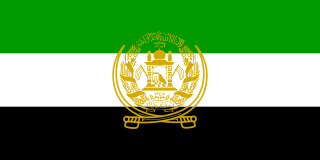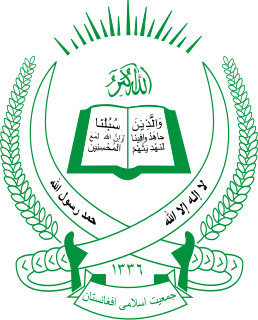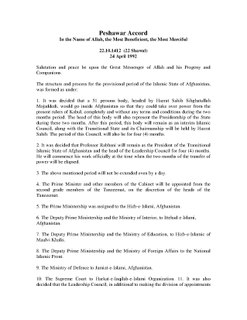The following lists events that happened during 1993 in Afghanistan .
Afghanistan remains a battleground, with rival factions fighting for power and pounding the capital with rockets. An estimated 10,000 people are killed, 750,000 are displaced, and many neighbourhoods in Kabul are devastated. Although the fighting lessens somewhat in the latter half of 1993, it is still unclear if the nation ultimately will be governable. Meanwhile, Najibullah, who received a promise of safe passage from the UN when it negotiated his abdication, remains in the UN office in Kabul, suffering from a kidney ailment. The UN has been unable to secure his freedom. Continuing hostilities also delay the homecoming of an estimated 3.8 million refugees in Iran and Pakistan, the largest refugee population in the world. The UN believes it will take until the end of 1995 for the 1.5 million Afghans remaining in Pakistan to return home. Afghanistan is the world's largest opium grower, according to the UN, having produced an estimated 2,000 tons in 1992. This is a concern not only for the West, where the production fuels the illegal heroin trade, but also at home, where it is estimated that 15% of all adult Afghan males age 15-40 are addicted to hard drugs.

Gulbuddin Hekmatyar is an Afghan politician and former Mujahideen Leader. He is the founder and current leader of the Hezb-e-Islami Gulbuddin political party. He has twice served as Prime Minister of Afghanistan during the 1990s.
The following lists events that happened during 1996 in Afghanistan.

This article on the History of Afghanistan since 1992 covers the time period from the fall of the Najibullah government in 1992 to the ongoing international military presence in Afghanistan.

The Islamic State of Afghanistan was the government of Afghanistan, established by the Peshawar Accords on 26 April 1992 by many, but not all, mujahideen Afghan parties, after the fall of the communist government. From 1996, it became a government in exile when the Taliban took power of Kabul and established the mostly unrecognized Islamic Emirate of Afghanistan. The Islamic State was in control of the country again after the Taliban government was overthrown by the United States in 2001 after the invasion. In 2002 it was succeeded by the Transitional Islamic State of Afghanistan.

Hezb-e-Islami, meaning Islamic Party is an Islamist organization that was commonly known for fighting the Communist Government of Afghanistan and their close ally the Soviet Union. Founded and led by Gulbuddin Hekmatyar, it was established in Afghanistan in 1975. It grew out of the Muslim Youth organization, an Islamist organization founded in Kabul by students and teachers at Kabul University in 1969 to combat communism in Afghanistan. Its membership was drawn from ethnic Pashtuns, and its ideology from the Muslim Brotherhood and Abul Ala Maududi's Jamaat-e-Islami. Another source describes it as having splintered away from Burhanuddin Rabbani's original Islamist party, Jamiat-e Islami, in 1976, after Hekmatyar found that group too moderate and willing to compromise with others.

Jamayat-E-Islami, sometimes shortened to Jamiat, is a Muslim political party in Afghanistan. The oldest Muslim political party in Afghanistan, it was originally formed as a student political society at Kabul University. The majority of the party are ethnic Tajiks of northern and western Afghanistan. It has a communitarian ideology based on Islamic law. During the Soviet–Afghan War and the following Afghan Civil War against the communist government, Jamiat-e Islami was one of the most powerful of the mujahideen groups. Burhanuddin Rabbani led the party from 1968 to 2011, and served as President of the Islamic State of Afghanistan from 1992 to 2001.

The Afghan Northern Alliance, officially known as the United Islamic Front for the Salvation of Afghanistan, was a united military front that came to formation in late 1996 after the Islamic Emirate of Afghanistan (Taliban) took over Kabul. The United Front was assembled by key leaders of the Islamic State of Afghanistan, particularly president Burhanuddin Rabbani and former Defense Minister Ahmad Shah Massoud. Initially it included mostly Tajiks but by 2000, leaders of other ethnic groups had joined the Northern Alliance. This included Abdul Rashid Dostum, Mohammad Mohaqiq, Abdul Qadir, Asif Mohseni and others.

The Hezb-e-Islami Gulbuddin, also referred to as Hezb-e-Islami or Hezb-i-Islami Afghanistan (HIA), is an Afghan political party and former militia, founded and led by Gulbuddin Hekmatyar.
The following lists events that happened during 2000 in Afghanistan.

This article covers the Afghan history from the Soviet withdrawal from Afghanistan on 15 February 1989 until 27 April 1992, the day after the proclamation of the Peshawar Accords proclaiming a new interim Afghan government which was supposed to start serving on 28 April 1992.

This article covers a part of the contemporary Afghan history that started between 28 April 1992, the day that a new interim Afghan government was supposed to replace the Republic of Afghanistan of President Mohammad Najibullah, and the Taliban's conquest of Kabul establishing the Islamic Emirate of Afghanistan on 27 September 1996.

This article covers the Afghan history between the Taliban's conquest of Kabul and their establishing of the Islamic Emirate of Afghanistan on 27 September 1996, and the U.S. and U.K. invasion of Afghanistan on 7 October 2001: a period that was part of the Afghan civil war that had started in 1989, and also part of the war in Afghanistan that had started in 1978.
The Afshar Operation was a military operation in Afghanistan that took place on February 11-12, 1993 during the Afghan Civil War (1992-96). The operation was launched by Ahmad Shah Massoud and Burhanuddin Rabbani's Islamic State of Afghanistan government and the allied Abdul Rasul Sayyaf's Ittehad-i Islami paramilitary forces against Gulbuddin Hekmatyar's Hezbe Islami and Abdul Ali Mazari's Hezbe Wahdat militias in the densely populated Afshar district in west Kabul. The Hazara-Hezbe Wahdat together with the Pashtun-Hezbe Islami of Hekmatyar had been shelling densely populated areas in northern Kabul from their positions in Afshar, killing thousands. To counter the shelling, government forces attacked Afshar in order to capture the positions of Wahdat and its leader Mazari, and to consolidate parts of the city controlled by the government.

Battle of Kabul refers to a series of intermittent battles and sieges over the city of Kabul during the period of 1992–1996.
The following lists events that happened during 1992 in Afghanistan.
The following lists events that happened during 1994 in Afghanistan.
The following lists events that happened during 1995 in Afghanistan.
The following lists events that happened during 1997 in Afghanistan.

On 24 April 1992, the Peshawar Accords were announced by several but not all Afghan mujahideen parties: Gulbuddin Hekmatyar, leader of Hezb-e Islami, had since March 1992 opposed these attempts at a coalition government.

The Islamabad Accord was a peace and power-sharing agreement signed on 7 March 1993 between the warring parties in the War in Afghanistan (1992–1996), one party being the Islamic State of Afghanistan and the other an alliance of militias led by Gulbuddin Hekmatyar. The Defense Minister of Afghanistan, Ahmad Shah Massoud, resigned his position in exchange for peace, as requested by Hekmatyar who saw Massoud as a personal rival. Hekmatyar took the long-offered position of prime minister. The agreement proved short-lived, however, as Gulbuddin Hekmatyar and his allies soon resumed the bombardment of Kabul.










